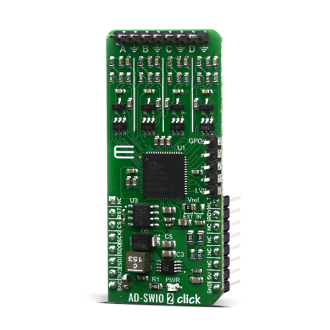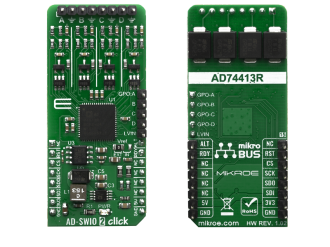
We strongly encourage users to use Package manager for sharing their code on Libstock website, because it boosts your efficiency and leaves the end user with no room for error. [more info]

Rating:
Author: MIKROE
Last Updated: 2020-04-14
Package Version: 1.0.0.0
mikroSDK Library: 1.0.0.0
Category: ADC
Downloaded: 4203 times
Not followed.
License: MIT license
AD-SWIO 2 Click is a Click board equipped with the AD74413R, from Analog Devices. The AD74413R is a quad-channel software configurable input/output solution for building and process control applications. The device provides a fully integrated single chip solution for input and output operation.
Do you want to subscribe in order to receive notifications regarding "AD-SWIO 2 click" changes.
Do you want to unsubscribe in order to stop receiving notifications regarding "AD-SWIO 2 click" changes.
Do you want to report abuse regarding "AD-SWIO 2 click".


Library Description
This library has ability to perform a full control of the AD-SWIO 2 Click board. This click can convert and measure voltage, current and resistance from 4 independent channels and 4 different diagnostics.
Key functions:
adswio2_err_t adswio2_generic_write( uint8_t reg_addr, uint16_t data_in ) - This function writes 16-bit data to the selected register.adswio2_err_t adswio2_set_ch_func( uint8_t channel, uint8_t ch_func ) - This function allows user to modify the functionality of the selected channel.adswio2_err_t adswio2_get_conv_results( uint8_t channel, uint16_t *data_out ) - This function allows user to get the converted results of the selected channel.Examples description
The application is composed of three sections :
void application_task( )
{
adswio2_rdy = adswio2_status_pin_ready( );
while ( adswio2_rdy == 0 )
{
adswio2_rdy = adswio2_status_pin_ready( );
}
adswio2_err = adswio2_get_conv_results( _ADSWIO2_SETUP_CONV_EN_CHA,
&adswio2_ch_a );
if ( adswio2_err == _ADSWIO2_ERR_STATUS_OK )
{
adswio2_res = adwdio2_ch_a;
adswio2_res /= _ADSWIO2_RANGE_RESOLUTION;
adswio2_res *= _ADSWIO2_RANGE_VOLT_MV;
adswio2_ch_a = adswio2_res;
WordToStr( adswio2_ch_a, adswio2_log );
Ltrim( adswio2_log );
mikrobus_logWrite( "* CH A converted result is ", _LOG_TEXT );
mikrobus_logWrite( adswio2_log, _LOG_TEXT );
mikrobus_logWrite( " mV", _LOG_LINE );
Delay_ms( 100 );
}
}
Additional Functions :
Other mikroE Libraries used in the example:
Additional notes and informations
Depending on the development board you are using, you may need USB UART click, USB UART 2 click or RS232 click to connect to your PC, for development systems with no UART to USB interface available on the board. The terminal available in all MikroElektronika compilers, or any other terminal application of your choice, can be used to read the message.